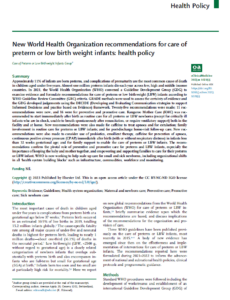
Summary
Approximately 11% of infants are born preterm, and complications of prematurity are the most common cause of death in children aged under five years. Almost one million preterm infants die each year across low, high and middle income countries. In 2021, the World Health Organization (WHO) convened a Guideline Development Group (GDG) to examine evidence and formulate recommendations for care of preterm or low birthweight (LBW) infants according to WHO Guideline Review Committee (GRC) criteria. GRADE methods were used to assess the certainty of evidence and the GDG developed judgements using the DECIDE (Developing and Evaluating Communication strategies to support Informed Decisions and practice based on Evidence) framework. Twenty-five recommendations were made; 11 recommendations were new, and 16 were for preventive and promotive care. Kangaroo Mother Care (KMC) was recommended to start immediately after birth as routine care for all preterm or LBW newborns (except for critically ill infants who are in shock, unable to breath spontaneously after resuscitation, or require ventilatory support) both in the facility and at home. New recommendations were also made for caffeine to treat apnoea and for extubation; family involvement in routine care for preterm or LBW infants; and for post-discharge home-visit follow-up care. New recommendations were also made to consider use of probiotics, emollient therapy, caffeine for prevention of apnoea, continuous positive airway pressure (CPAP) immediately after birth (with or without respiratory distress) in infants less than 32 weeks gestational age; and for family support to enable the care of preterm or LBW infants. The recommendations confirm the pivotal role of preventive and promotive care for preterm and LBW infants, especially the importance of keeping the baby and mother together, and empowering and supporting families to care for their preterm or LBW infant. WHO is now working to help scale up care for small and sick newborns, including organizational shifts in all ‘health system building blocks’ such as infrastructure, commodities, workforce and monitoring.
Key messages
- Twenty-five recommendations for care of preterm or low birthweight (LBW) infants were made by a WHO Guideline Development Group of experts; 11 were new, eight were changed and six were updated.
- Eleven interventions had strong recommendations for global implementation, while 11 interventions were recommended conditionally as implementation may vary with context; two interventions were not recommended.
- New recommendations included preventive and promotive care (e.g., community and immediate KMC, probiotics, emollient therapy) as well as care for complications (continuous positive airway pressure and caffeine for respiratory support) and family involvement and support. A good practice statement was also made, based on more limited evidence, that parental leave policies and entitlements should address the special needs of mothers and fathers of a preterm or LBW infant.
- The recommendations confirm the pivotal role of preventive and promotive care for preterm and LBW infants, especially the importance of keeping the baby and mother together, and empowering and supporting families to care for their preterm or LBW infant.
- These new recommendations are being integrated into care for small and/or sick newborns—including WHO tools such as the Integrated Management of Childhood Illness chartbooklet and the WHO Pocket Book of Hospital Care For Children—and will be adapted for regional and country-level implementation.